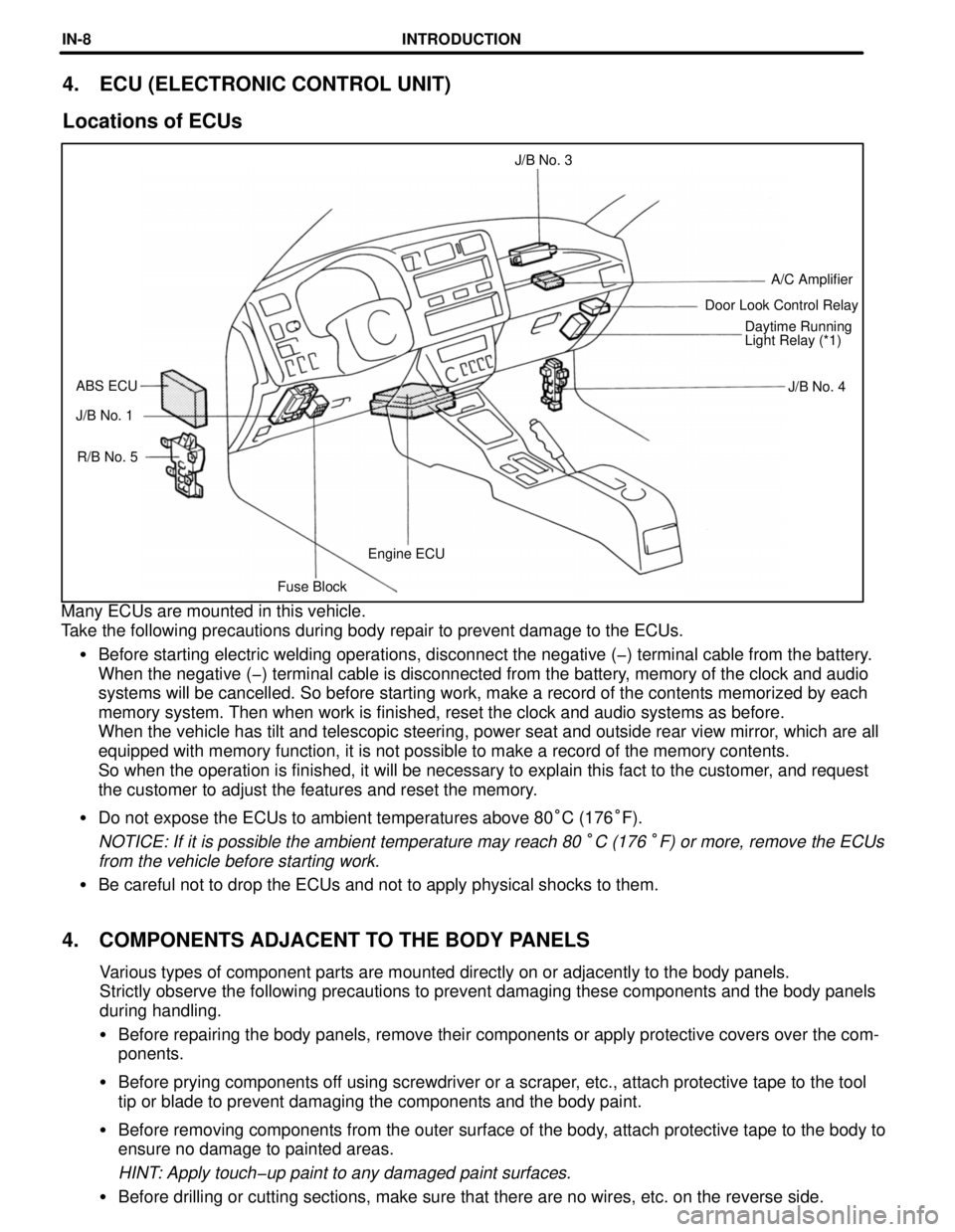Page 214 of 1354

Fuse BlockEngine ECU R/B No. 5 J/B No. 1J/B No. 4 ABS ECUDaytime Running
Light Relay (*1) Door Look Control RelayA/C Amplifier J/B No. 3
4. ECU (ELECTRONIC CONTROL UNIT)
Locations of ECUs
Many ECUs are mounted in this vehicle.
Take the following precautions during body repair to prevent damage to the ECUs.
�Before starting electric welding operations, disconnect the negative (-) terminal cable from the battery.
When the negative (-) terminal cable is disconnected from the battery, memory of the clock and audio
systems will be cancelled. So before starting work, make a record of the contents memorized by each
memory system. Then when work is finished, reset the clock and audio systems as before.
When the vehicle has tilt and telescopic steering, power seat and outside rear view mirror, which are all
equipped with memory function, it is not possible to make a record of the memory contents.
So when the operation is finished, it will be necessary to explain this fact to the customer, and request
the customer to adjust the features and reset the memory.
�Do not expose the ECUs to ambient temperatures above 80°C (176°F).
NOTICE: If it is possible the ambient temperature may reach 80 °C (176 °F) or more, remove the ECUs
from the vehicle before starting work.
�Be careful not to drop the ECUs and not to apply physical shocks to them.
4. COMPONENTS ADJACENT TO THE BODY PANELS
Various types of component parts are mounted directly on or adjacently to the body panels.
Strictly observe the following precautions to prevent damaging these components and the body panels
during handling.
�Before repairing the body panels, remove their components or apply protective covers over the comœ
ponents.
�Before prying components off using screwdriver or a scraper, etc., attach protective tape to the tool
tip or blade to prevent damaging the components and the body paint.
�Before removing components from the outer surface of the body, attach protective tape to the body to
ensure no damage to painted areas.
HINT: Apply touch-up paint to any damaged paint surfaces.
�Before drilling or cutting sections, make sure that there are no wires, etc. on the reverse side.
INTRODUCTIONINœ8
Page 328 of 1354
DI−8
− DIAGNOSTICSENGINE
1996 RAV4 (RM447U)
6. BASIC INSPECTION
When the Malfunction code is not confirmed in the DTC check, troubleshooting should be performed in the
order for all possible circuits to be considered as the causes of the problems.
In many cases, by carrying out the basic engine check shown in the following flow chart, the location causing
the problem can be found quickly and efficiently. Therefore, use of this check is essential in engine trouble-
shooting.
1 Is battery positive voltage 11 V or more when engine is stopped?
NO Charge or replace battery.
YES
2 Is engine cranked?
NO Proceed to STARTING and continue to trouble-
shoot.
YES
3 Does engine start?
NO Go to step 7.
YES
Page 506 of 1354

DI−186
− DIAGNOSTICSAUTOMATIC TRANSAXLE (A540H)
1996 RAV4 (RM447U) If pressure is low in the D position only
�D position circuit fluid leakage
�Forward clutch defective
If pressure is low in the R position only
�R position circuit fluid leakage
�Direct clutch defective
�1st and reverse brake defective
10. Center Differential Control Clutch:
HYDRAULIC TEST
(a) Preparation.
(1) Warm up the ATF.
(2) Remove the test plug and connect SST (See page AX−18 for the location to connect SST).
SST SST 09992−00094 (09992−00111)
CAUTION:
�Perform the test at normal operating ATF temperature 50 − 80°C (122 − 176°F)
�The line pressure test should always be carried out in pairs. One should observe the conditions
of wheels or wheel stoppers outside the vehicle while the other is performing the test.
(b) Measure the center differential clutch control pressure.
(1) Start the vehicle and open the accelerator open 50 % or more and check that the center differen-
tial clutch control pressure is in the range from more than 294 kPa (3.0 kgf/cm
2, 42 psi).
(2) Fully close the accelerator and check that the SST registers 9.8 kPa (0.1 kgf/cm
2, 1.4 psi) or less.
CAUTION:
�Confirm safety of the road before checking.
�Take care to avoid slip when you start the vehicle on a paved road.
�Check the pressure at normal driving ATF temperature 50 − 80°C (122 − 176°F).
Reference:
To measure center differential control pressure to be measured with the solenoid opened by applying voltage
to it, refer to the following:
�Prepare a sub−assembly for checking as follows:
Prepare a supply connector (Part No. 90980−10629, or 90980−11143)
Connect a harness of 2 − 3 m (6.6 − 9.8 ft) to terminal 1 of the connector.
Place a bulb of 24W in between the harness.
Connect a harness of 2 − 3 m (6.6 − 9.8 ft) to terminal 3 of the connector.
�Connect the inspection’s sub−harness assembly to the solenoid connector of the transfer.
Connect terminal 1 of the sub−harness to the battery’s positive (+) terminal, and terminal 3 of the sub−
harness to the battery’s negative (−) terminal.
�Measure the center differential control pressure at idling and when performing the stall test (When 1st
gear).
Engine speedSub−harnessLine pressure kPa (kgf/cm2, psi)
IdlingConnected363 − 422 (3.7 − 4.3, 53 − 61)
Stall (Shift solenoid valve SLD OFF)Connected735 − 863 (7.5 − 8.8, 107 − 125)
Stall (Shift solenoid valve SLD ON)Connected1,324 − 1,549 (13.5 − 15.8, 192 − 225)
All rpmNot connected9.8 (0.1, 1.4) or less
Page 773 of 1354

3
HOW TO USE THIS MANUAL B
This manual provides information on the electrical circuits installed on vehicles by
dividing them into a circuit for each system.
The actual wiring of each system circuit is shown from the point where the power
source is received from the battery as far as each ground point. (All circuit diagrams
are shown with the switches in the OFF position.)
When troubleshooting any problem, first understand the operation of the circuit where
the problem was detected (see System Circuit section), the power source supplying
power to that circuit (see Power Source section), and the ground points (see Ground
Points section). See the System Outline to understand the circuit operation.
When the circuit operation is understood, begin troubleshooting of the problem circuit
to isolate the cause. Use Relay Location and Electrical Wiring Routing sections to find
each part, junction block and wiring harness connectors, wiring harness and wiring
harness connectors, splice points, and ground points of each system circuit. Internal
wiring for each junction block is also provided for better understanding of connection
within a junction block.
Wiring related to each system is indicated in each system circuit by arrows (from
, t o ). When overall connections are required, see the Overall Electrical Wiring
Diagram at the end of this manual.
Page 814 of 1354
44
H POWER SOURCE (Current Flow Chart)
The chart below shows the route by which current flows from the battery to each electrical source (Fusible Link,
Circuit Breaker, Fuse, etc.) and other parts.
The next page and following pages show the parts to which each electrical source outputs current.
* These are the page numbers of the first page on which
the related system is shown.
The part indicated is located somewhere in the system,
not necessarily on the page indicated here.
[LOCATION]�: J/B No. 1 (See page 20)�: J/B No. 4 (See page 23)
�: R/B No. 6 (See page 25)�: Fusible Link Block (F7 on See page 28)